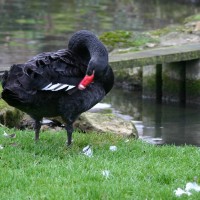
Black Swan - Cygnus atratus
Expand and collapse the sections below by clicking on the title or + / - icons.
Short description of Cygnus atratus, Black Swan
The black swan is highly distinctive, being immediately recognisable as a swan by its large size, long-necked shape and mainly aquatic behaviour but black in colour, with a deep red bill and eyes. The flight feathers of the wing, normally completely hidden when the bird is at rest, are white. There is a white band across the red bill. The folded wings have a curiously corrugated appearance. Immatures are grey with dusky tips to the white flight feathers.
Impact summary: Cygnus atratus, Black Swan
Black swans can be aggressive towards native waterfowl and may reduce local breeding populations of such species. Interbreeding with mute swan Cygnus olor has been recorded.
Habitat summary: Cygnus atratus, Black Swan
Like other swans, black swans typically occupy larger water bodies, still or flowing, from which they can easily take to the wing. They occasionally graze on freshwater marshes. Some occur regularly at brackish or salt-water sites.
Overview table
| Environment | Terrestrial and Freshwater |
|---|---|
| Species status | Non-Native |
| Native range | Australia |
| Functional type | Herbivore |
| Status in England | Non-Native |
| Status in Scotland | Non-Native |
| Status in Wales | Non-Native |
| Location of first record | Carshalton |
| Date of first record | 1851 |
Origin
The native range of the black swan is in southern Australia, including Tasmania. It is also native to New Zealand but the present breeding population is derived largely from introduced birds.
First Record
Black swans were first imported into GB around 1791. The first known record in the wild in GB was of breeding at Carshalton, south London, in 1851.
Pathway and Method
Black swans are popular subjects for aviculture and have been widely introduced onto park lakes and onto the River Thames. Some birds present in the wild may have escaped from captivity but probably most will have been released deliberately. Some interchange is likely with non-native populations elsewhere in Europe.
Species Status
Black swans are widely reported in GB, from the Isles of Scilly north to the Western Isles and Shetland, and may be on the brink of establishing a self-sustaining population. A substantial breeding population has become established in the Netherlands and breeding also occurs in Belgium, France, Germany, Italy and more rarely elsewhere in Europe. A population in Austria has been eradicated.
Dispersal Mechanisms
In Australia, the black swan is now recognised as a highly mobile species that is capable of exploiting ephemeral wetland resources almost throughout the continent. Occasional migrants have reached New Zealand and southern New Guinea. In GB it has been observed passing coastal migration watchpoints and has reached remote islands, in some cases perhaps from starting points in continental Europe.
Reproduction
Black swans form monogamous pairs that may nest singly or in colonies. Each builds a large nest of reeds and grasses close to the water's edge, often on a small island. Females lay 4–8 eggs. In Australia, the breeding season varies according to local conditions. In GB, breeding is often rather early in the year and mortality of cygnets appears to be high. Hybridisation with mute swan has been recorded on several occasions.
Known Predators/Herbivores
None known.
Resistant Stages
None known.
Habitat Occupied in GB
Black swans occur on lakes, ponds, rivers and sheltered estuaries, most often at places where wildfowl are fed by the public.
Sightings in GB are regular at many lowland sites, for example the Thames Basin, the Cheshire Plain and the Norfolk Broads. Breeding has been recorded at locations north to Orkney.
Environmental Impact
Breeding black swans are aggressive and may reduce the opportunities for native waterfowl, especially mute swan, to nest nearby. On occasion, black and mute swans will hybridise.
Health and Social Impact
Black swans are generally popular with people but can cause problems through aggressive food-begging. They also contribute to trampling and fouling of amenity grasslands and their droppings reduce the water quality of park lakes and ponds.
Economic Impact
The presence of black swans may be considered a tourist attraction. At Dawlish in Devon there is a small group of pinioned birds for which the town is famous. In Australia and New Zealand damage to agricultural crops has been recorded.
Identification
Kear, J. (2005) Ducks, geese and swans. Oxford University Press, Oxford.
Biology, ecology, spread, vectors
Braithwaite, L.W. (1977) Ecological studies of the Black Swan I. The egg, clutch and incubation. Australian Wildlife Research, 4, 59–79.
Braithwaite, L.W. (1981) Ecological studies of the Black Swan II. Colour and plumage changes, growth rates, sexual maturation and timing and frequency of breeding. Australian Wildlife Research, 8, 121–133.
Management and impact
Banks, A.N., Wright, L.J., Maclean, I.M.D., Hann, C., Mellan, H.J. & Rehfisch, M.M. (2009) Review of the status of introduced non-native waterbird species in the area of African–Eurasian Waterbird Agreement: 2007 update. Research Report 489. BTO, Thetford.
General
Frith, H.J. (1982) Waterfowl in Australia. Angus & Robertson, Sydney.
Spotted this species?
Distribution map
View the Distribution map for Black Swan, Cygnus atratus from NBN Atlas

Native range map
View an interactive native range map for Black Swan, Cygnus atratus
Risk assessment
Risk assessment for Cygnus atratus. See a full list of non-native species Risk assessments.
ID Sheet
ID Sheet for Cygnus atratus . See a full list of non-native species ID Sheets.







